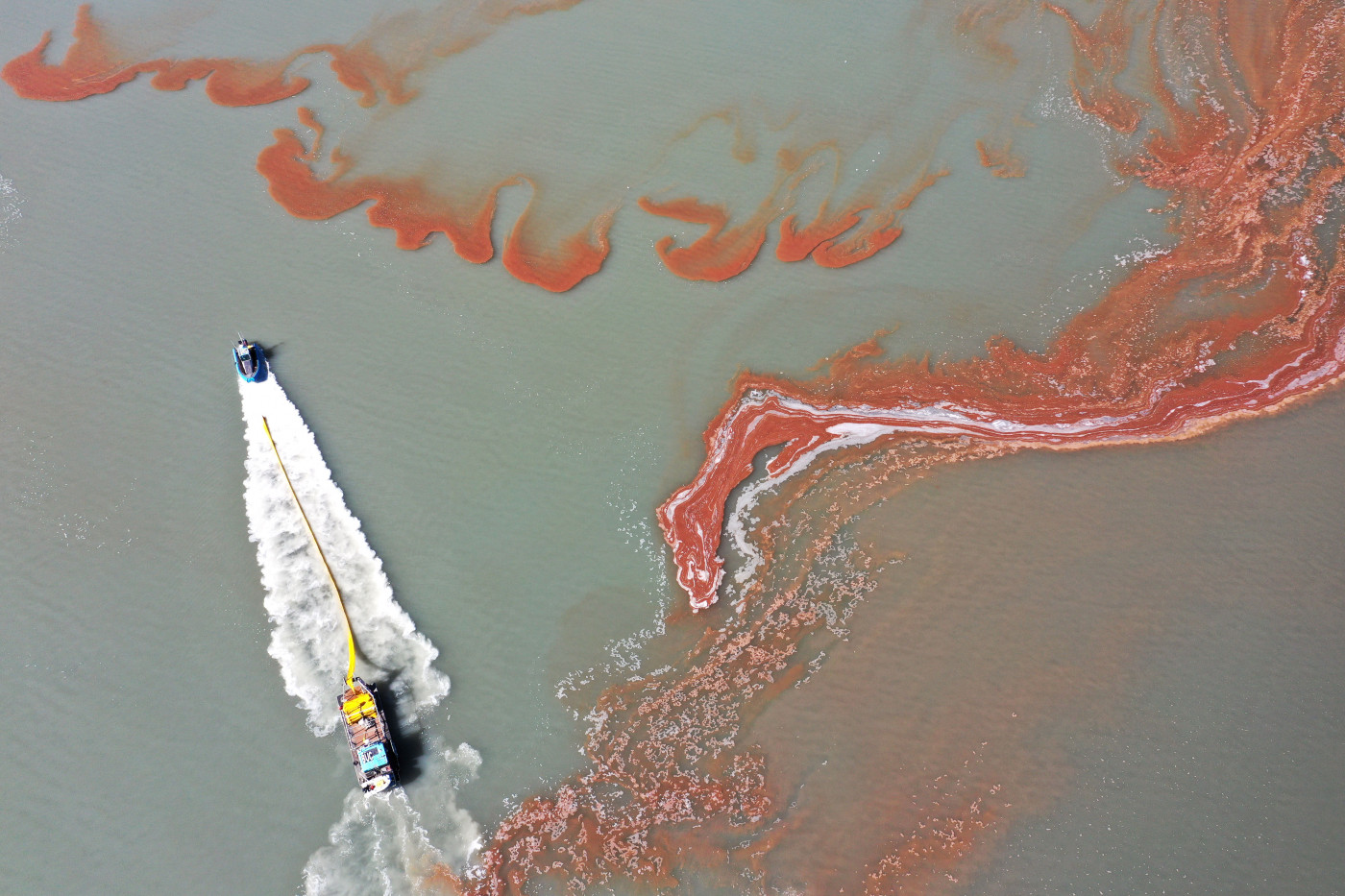Saving the Great Salt Lake is important because it makes a critical international industry more sustainable.
Editor’s note: This story is part of a series of stories by the Great Salt Lake Collaborative that asks the question: Why save the Great Salt Lake? It explores what opportunities open up in agriculture, daily life, industry and recreation by restoring the lake — or are ultimately lost without it.
Nobody grows up thinking they'll work in the brine shrimp industry. At least Timothy Hawkes, a self-described “accidental sea monkey lawyer,” didn't. He stumbled into the job of legal counsel for the Great Salt Lake Brine Shrimp Cooperative about seven years ago, early in his service in the Utah Legislature.
The next thing he knew, he was on a United Nations Food and Agriculture Organization-sponsored panel presenting information about management of the Great Salt Lake and whether it could produce enough brine shrimp to feed the world.
Utah, Hawkes says, longs for a place on the global stage. For years state leaders have argued for the importance of its agricultural products, for its potential to become a major energy producer — it even hosted the Winter Olympics. But as Utah cast about for a way to make its mark, the eyes of the world had already turned to the Beehive State. Not for its innovative tech companies or its picturesque national parks. No, they came to this landlocked state for the seafood.
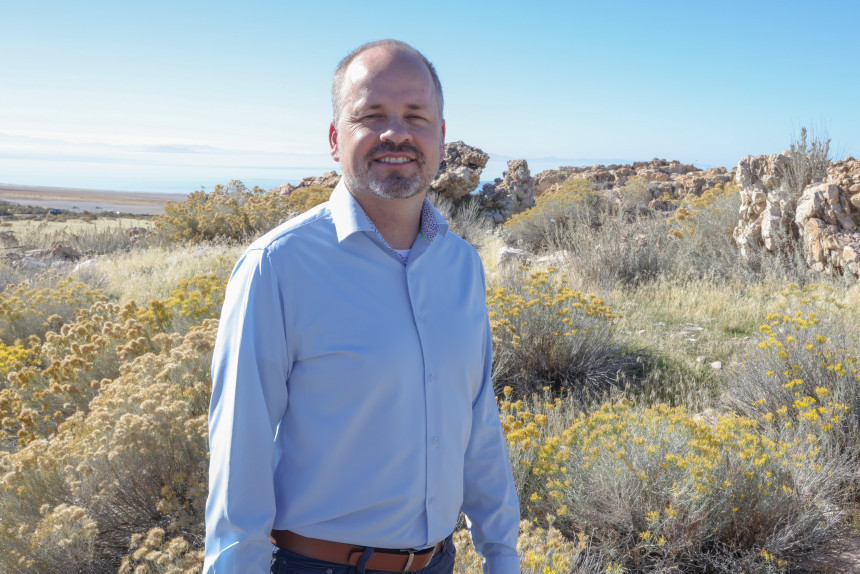
Tim Hawkes, pictured at Antelope Island Oct. 19, 2023, is the vice chair and general counsel of the Great Salt Lake Brine Shrimp Cooperative, which harvests and distributes brine shrimp cysts, which is used to feed farmed fish. (Madi Ormond, PBS Utah.)
The world population is expected to grow by nearly 2 billion persons over the next 30 years, posing significant questions about how to feed all these additional people in the face of a changing climate, increasing urbanization and conflict in some of the world's most critical food-producing countries. Given the limits on how much more land and fresh water can be converted to agricultural use — and growing opposition around the world to the deforestation this would require — the Food and Agriculture Organization of the United Nations believes that industrial fish farming will be critical to preventing hunger in the future.
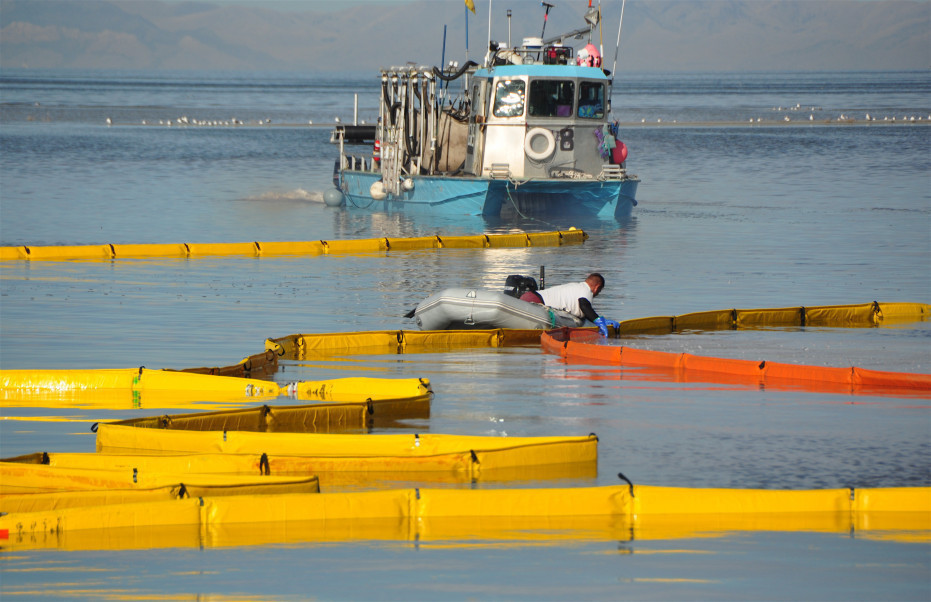
Fishermen collecting brine shrimp (Artemia) cysts using booms and specialized watercraft on Great Salt Lake. Courtesy Great Salt Lake Artemia.
But like other livestock, farmed fish require a food source. And popular carnivorous species, including shrimp, prawns, crab, sea bass, snapper and many tropical fish species, cannot survive to adulthood without artemia — what we know in Utah as brine shrimp.
The Great Salt Lake, according to industry experts, is the world's single largest source of brine shrimp. And while this may come as a surprise to the locals, they say it's also the most sustainable source.
“The eyes of the world are on us — Utahns like that narrative, but the eyes of the world really are,” Hawkes says. “If Utah can stick the landing — if we can execute that vision [of saving the Great Salt Lake] — people will come from all over the world to study what we did.”
Brine Shrimp 101

A close-up of a female brine shrimp. Courtesy Bridget Dopp, Great Salt Lake Institute, Westminster University.
At first glance, the brine shrimp industry in Utah may appear modest, employing maybe 170 individuals within the state. But those numbers don't account for the global impact of brine shrimp, which support an estimated 10 million metric tons of seafood, produced mostly by a few big corporations and a lot of small family-owned fish and shrimp farms in developing economies in Latin America, Asia and Africa, according to Patrick Sorgeloos, a founder of the Artemia Reference Center at Ghent University, in Belgium.
This has not always been the case, Sorgeloos says — in fact it's a relatively recent development. As recently as the 1970s, leading experts in aquaculture believed a need for some form of tiny, live zooplankton would forever limit the domestic production of species like shrimp.
“At that time everyone was saying we can make a dried pellet, just like you feed chickens or pigs,” Sorgeloos says. But they quickly realized that in their earliest life stages, shrimp and some carnivorous fish couldn't survive on pellet feed because they lacked critical digestive enzymes they would typically acquire from consuming live zooplankton in the wild.
The challenge, Sorgeloos continues, is that zooplankton don't lend themselves to being shipped and stored for convenient use by farmers. But artemia have adapted to live in some of the world's most extreme, and unstable, environments — saline lakes. Under stress, brine shrimp will produce cysts — often incorrectly referred to as eggs — to survive. In Utah these cysts help the artemia survive over the winter.
When dry, the cysts are naturally shelf stable, with the brine shrimp only emerging from their encysted state when reintroduced to water.
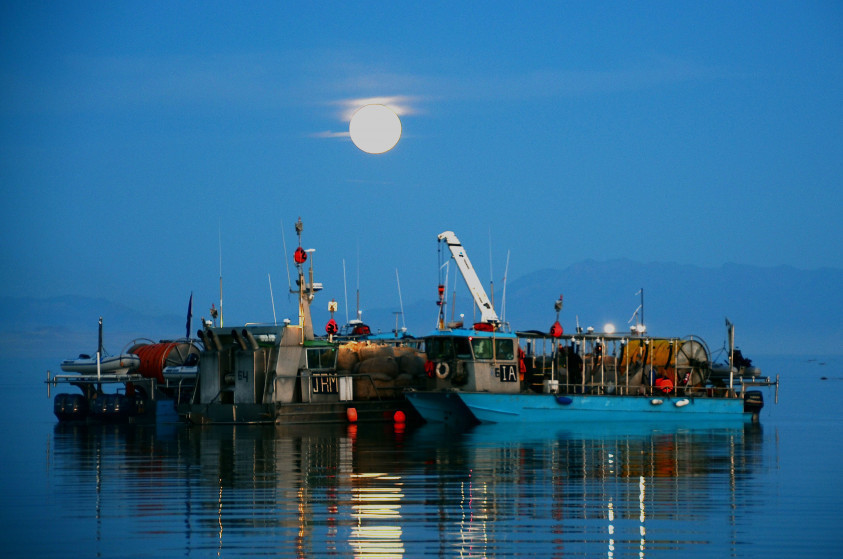
Specialized fleet of harvest watercraft used in harvesting brine shrimp (Artemia) on Great Salt Lake. Courtesy Great Salt Lake Artemia.
“You can ship them to Thailand, Malaysia, Indonesia, and you can have them on the shelf, and when you start your farming of shrimp, you can take a can of Great Salt Lake artemia cysts and the next morning have plankton food for your baby fish or shrimp,” Sorgeloos says.
The idea, when early aquaculture pioneers first proposed it, seemed ludicrous. Brine shrimp were available at the time, but most came from coastal estuaries in San Francisco and they were sold for top dollar to hobbyists raising tropical fish in high-end aquariums. How was anyone going to feed a growing global population with such a scarce and expensive resource?
But there was another source of artemia that could vastly increase the available supply — the Great Salt Lake. And that is how Utah's brine shrimp industry was born.
Today farmers from Vietnam and Indonesia — people who have never been to the United States — ask Hawkes about the health of the Great Salt Lake. Even here in Utah, if you buy a bag of frozen shrimp from the store, there's a 50-50 chance that shrimp was raised on artemia from the Great Salt Lake.
“It has a global impact that I think is poorly understood,” Hawkes says. “If the Great Salt Lake goes away, it would drive up costs and limit our ability to produce food in a lot of the developing world, which complicates food scarcity and other problems. This is a body of water that very much has a global reach and a global impact, and if the Great Salt Lake went away, the world would be poorer for it.”
Great Salt Lake's Legacy
Given the explosive growth of aquaculture since the 1970s, the Great Salt Lake is no longer the world's only source of artemia. It does still supply a little more than a third of the world's brine shrimp and retains its place as the largest sole producer of artemia, Sorgeloos says, but even the greatest salt lake in the world couldn't by itself supply the 3,500 metric tons of artemia that is now consumed annually. So brine shrimp are increasingly extracted from other saline lakes and coastal waters, primarily in central Asia, Siberia and China.
That doesn't make the Great Salt Lake any less important to aquaculture, Sorgeloos says. Rather, the lake's significance in the industry continues to grow.
In the 1990s, two decades into the brine shrimp industry's success, the Great Salt Lake was still essentially the world's only source of artemia, Sorgeloos explains. By then it was producing 1,000 metric tons of dried brine shrimp cysts per year, and demand continued to grow. Then came a wet cycle driven by El Nino — a cyclic climate pattern that involves above-average temperatures in the eastern Pacific Ocean and typically wetter weather in the Western U.S. The salinity of the Great Salt Lake dropped, and brine shrimp populations suffered.
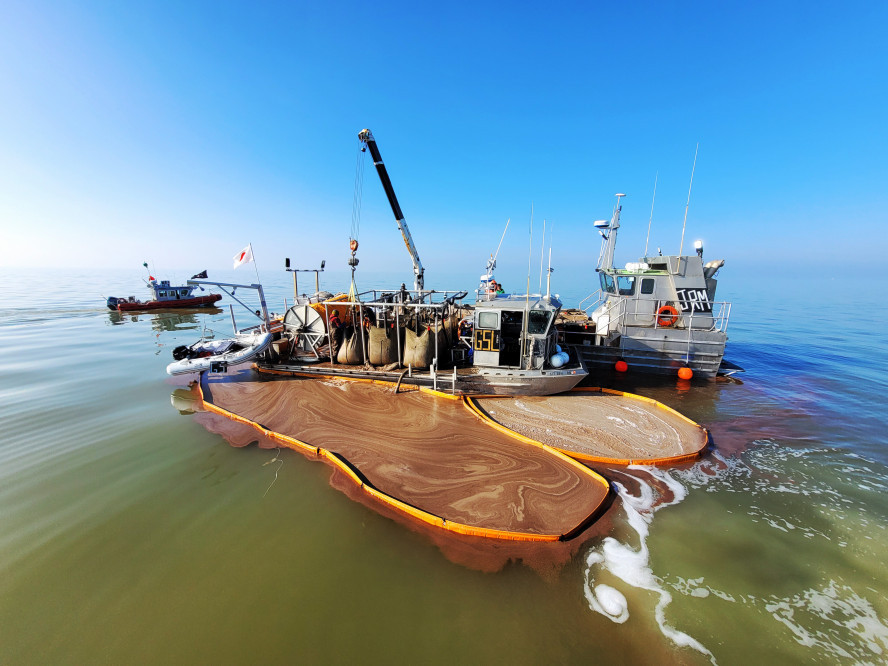
Specialized harvesting boats collect brine shrimp (Artemia) using containment booms, then pump them onboard for transportation and further processing onshore. Courtesy Great Salt Lake Artemia.
At the same time, Hawkes recalls, wild fisheries around the world began to experience population collapse as a result of overfishing. This triggered a sense of reckoning among the brine shrimp fishers of the Great Salt Lake as they realized if they took too many cysts, particularly during years when the population was already struggling, the brine shrimp might never recover.
Recognizing the resource is finite, the industry invited regulation and worked in collaboration with state regulators to develop a management model that places a cap on how many brine shrimp cysts may be harvested from the Great Salt Lake to ensure a sustainable harvest year after year, Hawkes says. The system remains in place to this day, with some refinements worked out over the years.
Other saline lakes have been less lucky. Remnants of the Aral Sea straddling the border of Kazakhstan and Uzbekistan, which until recently produced 500 metric tons of brine artemia, has become too saline to support brine shrimp. Iran’s Lake Urmia, another former source of artemia, now produces nothing. Other lakes of importance to the industry have vanished or remain in jeopardy, prompting the U.N. meetings on food security that ultimately summoned Hawkes and other experts to the international stage.
For all the talk about the jeopardy the Great Salt Lake currently faces, Sorgeloos says, it remains perhaps the best managed saline lake in the world. He sees current efforts to save the lake as an extension of its existing legacy — and a beacon of hope for the entire aquaculture industry.
“Utah should be proud,” Sorgeloos says. “If we want to save these terminal lakes, not just the Great Salt Lake, we will use the Great Salt Lake as an example.”
A Mayo Clinic for Brine Shrimp

This illustration shows renderings for a research facility at Antelope Island. It was envisioned as a place for researchers from around the world to visit to study saline lakes. It was created by Utah State University’s Landscape Architecture & Environmental Planning seniors in their capstone class in Spring 2023.
With the success of aquaculture around the world on the line, researchers and industry leaders hold regular workshops to discuss the state of the Great Salt Lake, and how programs initiated here might be replicated elsewhere. These meetings have taken place all around the globe — a rotation that is in keeping with the brine shrimp industry's international footprint. But Sorgeloos believes Utah could play an even greater role in the industry's future if the state built a research center to serve as a home base for the study of saline lakes. There's even a chance the U.N. could provide financial backing for such a center, he says.
Sorgeloos isn't the only person to float the idea of starting an international saline lakes research center in Utah. This past spring, seniors in landscape architecture at Utah State University hatched plans for a possible research facility on Antelope Island as part of a senior capstone project. Although the concept was left partially unfinished as the semester came to a close and the students graduated and moved on to their next endeavors, professional practice professor David Anderson in USU’s Department of Landscape Architecture and Environmental Planning believes the idea could have real potential.
“If you could create a place that was globally recognized, you could invite researchers from all around the world to come participate and study and generate work that could have an impact at other saline lakes that are under threat,” he says. “There are globally recognized research facilities for a myriad of topics — Johns Hopkins or the Mayo Clinic for medicine — and it really ought to be of that caliber, but for anything related to the function and health of saline lakes around the world.”
The plans drawn up by his students, Anderson says, included space for classrooms and living quarters for up to 30 visiting experts. Providing residential facilities as well as space for research and for learning would allow universities and businesses worldwide to send their top scientists to Utah to spend time on the Great Salt Lake. It wouldn't have to be limited to brine shrimp — other industries like mineral and salt producers could send experts as well, and over time these researchers would develop relationships and improve the global understanding of saline lake ecosystems.
Of course, Anderson continues, a facility like this would have significant educational and public outreach components as well, exposing future generations of Utahns to a host of potential careers in environmental engineering, ecology, biology and many other fields.
Locating the facility in a place like Antelope Island would increase the level of difficulty for the architects — it would come with a great need to respect the landscape and minimize the impact on the environment. And it may not be possible to locate all the facilities the research center would need on the island — aquaculture research, for example, would require access to fresh water in quantities that just aren't available on the lake. But if the researchers themselves lived and studied on the center of the lake, Anderson believes it could provide the inspiration needed to spur global change.
“If you put them in a facility where they are looking at the situation change before their eyes, it ramps up the necessity, the importance and the urgency — and the stewardship that they are, I believe, required to take on,” Anderson says.
And make no mistake, the future needs a healthy lake. Beyond brine shrimp, other organisms that live in the lake can survive intense cold and relentless sun exposure — the kind of UV intensity that might be present on another planet, according to Bonnie Baxter, director of the Great Salt Lake Institute at Westminster College.
“I have received funding from NASA for studying the extreme microbial life in Great Salt Lake as an analogue for potential life from lakes that dried up on Mars,” she said. These microbes can dry up inside minerals and survive over thousands of years. Some Great Salt Lake microbes can live within salt crystals. As we look for life on other planets, Baxter says, the Great Salt Lake will teach us what to look for.
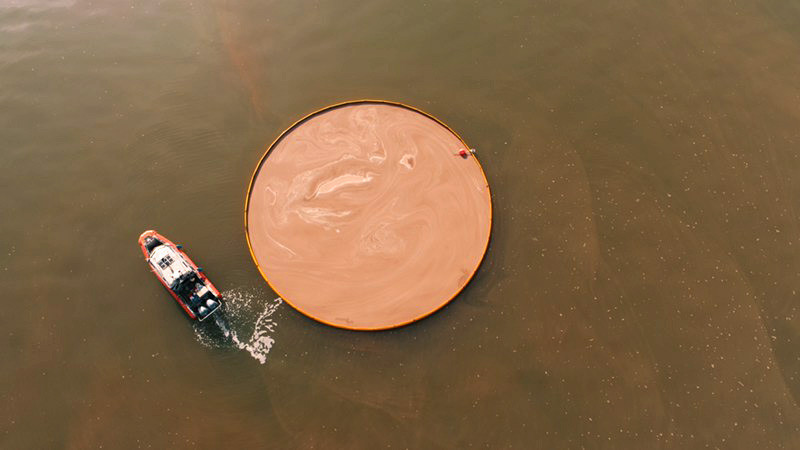
Aerial view of enclosed brine shrimp (Artemia) streak using containment booms on Great Salt Lake. Courtesy Great Salt Lake Artemia.
With an infusion of perspective, Anderson believes the world could come together and make a difference — for the sake of all human beings both currently living, and those yet to be born.
“In addition to significant local and regional impacts such as toxic dust and lack of snow along the Wasatch Front, there are more far-reaching implications,” Anderson says. “It truly affects people starving — that's a message that's incredibly thought provoking.”

